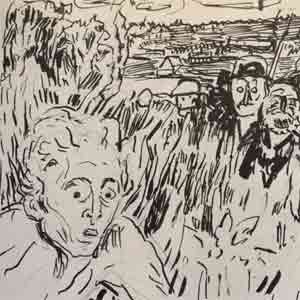

Why Peer Gynt? Easy!
It's a rarely performed gem. Edvard Grieg's magnificent music is familiar and much-loved. We are performing it as it was meant to be - with Henrik Ibsen’s iconic play.
It's authentic. We are lucky to have internationally-respected, Norwegian Ibsen translator and dramaturg, May-Brit Akerholt as consultant who draws on her own productions of Peer Gynt.
It's timeless. The themes of selfishness, self-indulgence and greed would ring bells for 21st century audiences.
Its a blast. Its energetic action, colourful tableaux and spectacular events are a perfect fit for Alison’s innovative choreography and Sandy’s creative designs.
It's serious. Ibsen wrote a highly political dramatization of a life wasted in pursuing dreams, fleeing from responsibility, and seeking power instead of love.
It's Norwegian. No words necessary!
3 reason's to hear Grieg's music live
The Peer Gynt Suites have been appropriated for everything from pop music to paint commercials. Even Duke Ellington had his own arrangement. There are many reasons why they are so loved. Here are three ...
1. The music is wonderful!
It gets "borrowed" so often because it is beautiful and creates incredibly vivid images. Grieg enchants us with haunting melodies, thrilling moments, a plaintive solo, and the most downright frantic action you’ll hear in one performance.
Cleanse your mind of the tired cliches, by hearing it played live with soul and heart, by the first-class musicians in our 30-piece orchestra.
2. It’s big emotion.
It’s big – a big orchestra, big emotion, big storytelling. It features a full symphony orchestra, judiciously trimmed to fit our venue, but still featuring flutes, piccolos, oboe, clarinets, bassoon, horns, trumpet, trombones, timpani, a full array of percussion and a rich body of 15 string players..
Our Peer Gynt has a total of 26 music numbers. Grieg used only eight movements for his two suites (four each). In our end-to-end tale, there's a lot more. We give you all the original pieces in their dramatic context. Let the big show begin!
3. each piece has it's own appeal. Take Suite No.1 for starters!
Hall of the Mountain King
In the Hall of the Mountain King, in Act II, Peer visits the cavern of the ferocious Troll King and his grotesque dancing subjects. It uses a single motif, begun at low pitch by the bassoons, double basses, and cellos with staccato articulation, and gradually extends to the full orchestra. As the higher pitched instruments join in it becomes faster and louder. Except for the first few bars, the entire movement repeats a four-measure phrase, from soft to loud, continually increasing in intensity.
Åse’s Death
Benjamin Northey, Conductor of the Sydney Symphony Orchestra, described Åse’s Death in Act III as "one of the greatest musical miniatures ever written" to our Music Director Peter Alexander. It is an elegy, describing the solitary death of Peer’s mother, who he mourns deeply. It has slow, sad, haunting harmonisation, and the repetition of its phrases evokes the monotony of grief. It is scored for a large body of muted stringed instruments.
Morning Mood
Morning Mood from Act IV is often assumed to be set in Norway. It is really sunrise in the North African desert. In Peer’s awakening and reverie, he fancies he is king of all he surveys, and the flute and oboe sing to each other like morning birds. As the pitch and dynamics rise, the violins play the pastoral theme, interwoven with the smooth singing of the cellos (cantabile). French horns take up the melody towards the end, before the flute and bassoon bring it to a peaceful close.
Anitra’s Dance
Also set in the North African desert in Act IV, Anitra’s Dance is a sensual waltz in mazurka time for a dancing girl in the tent of a Bedouin chieftain. The independent melody of the cello runs through the piece mirroring the agility, grace, and suppleness of Anitra’s gestures. Full orchestra again, without wind instruments. The use of the triangle with the string instruments, was Grieg’s 19th Century conception of “Oriental colour”!
It's beloved, it's big, it's brilliant! That's 3 good reasons right there.




